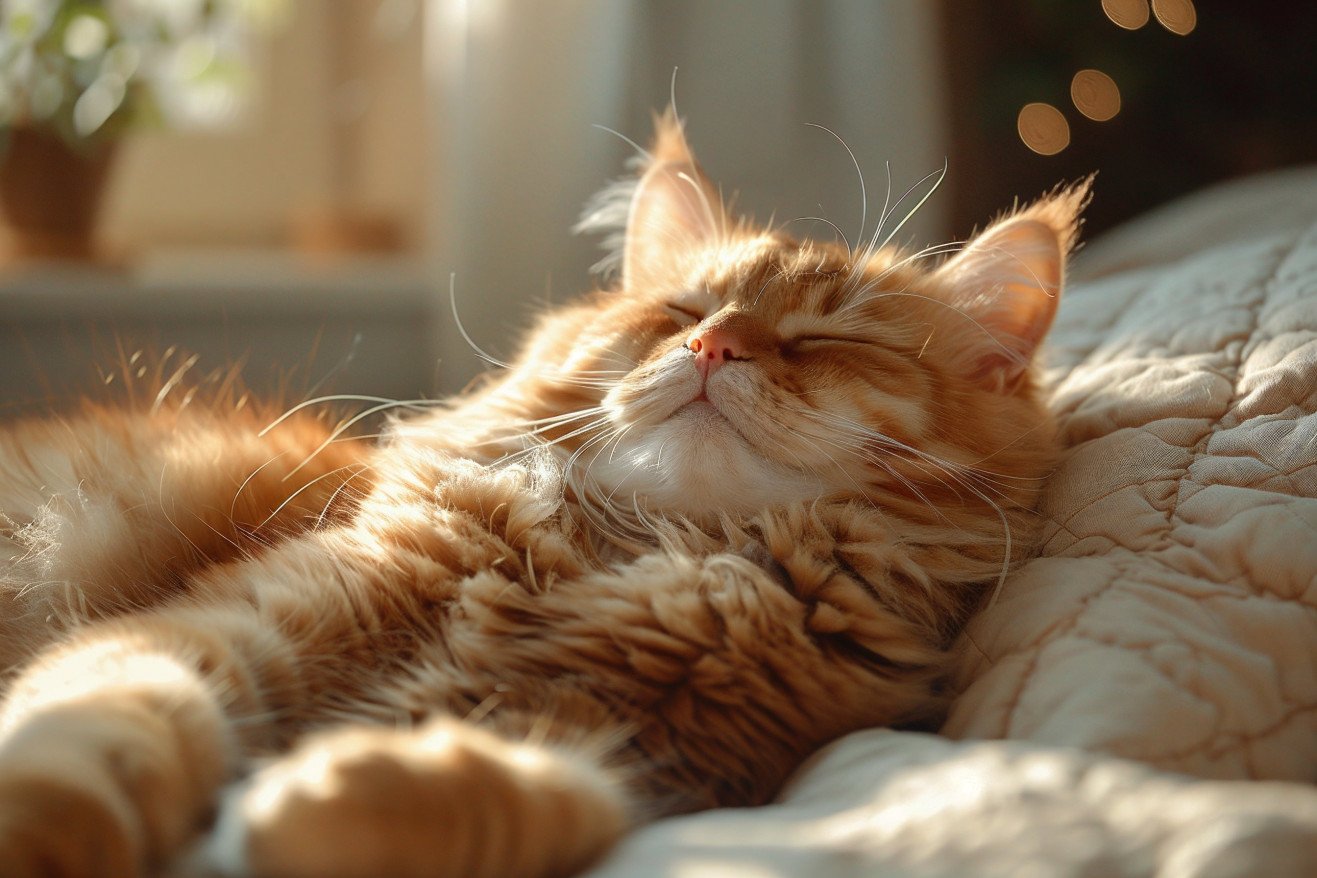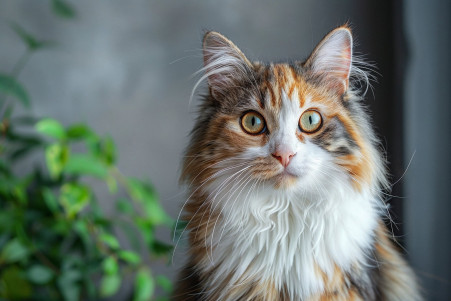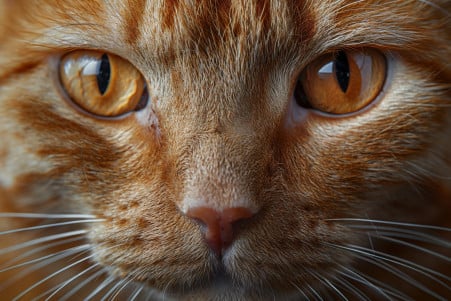Can Cats Smile? Understanding the Science of Feline Happiness
27 February 2024 • Updated 26 February 2024

Cats are known for their inscrutable faces, but can they really smile? The truth is that cats don’t smile in the way that humans do. Instead, they show happiness through a number of different behaviors, including purring, slow blinking, and kneading. A cat’s ‘smile’ may be a response to scents, known as the ‘flehmen response’, and not an indication of joy.
In this article, we’ll delve into the world of cat behavior and communication, combining insights from ethology, animal psychology, and neuroscience. We’ll look at the latest research and expert opinions to find out what cat expressions can tell us about how cats feel. By the end of this article, you’ll have a better understanding of the many ways that cats communicate their emotions, happiness, and their version of a smile.
Can cats smile?
Understanding the Nuances of Cat Facial Expressions
Cats have a wide range of facial expressions, with almost 300 different expressions identified in a study published in Behavioral Processes. The study, which used a cat-specific version of the Facial Action Coding System, followed 53 domestic shorthair cats and recorded over 194 minutes of their interactions, finding expressions associated with different emotions and motivations.
From friendly to aggressive, each expression is associated with different physical cues, including ear movements and whisker positions, according to Smithsonian Magazine. The study also found that the context of the expression is important in understanding what the cat is trying to communicate. For example, the cat’s smile of flattened ears and narrowed pupils may look like a human smile, but it’s actually a sign of aggression.
In addition to debunking the myth of the cat’s smile, the study shows that cat expressions are complex and nuanced, and that to understand them, it’s important to pay close attention to the details of their facial expressions. Doing so can help people form a stronger bond with their pets and lead them to the next level of understanding feline communication: body language, vocalizations, and scent.
Understanding Your Cat’s Body Language
In addition to facial expressions, cats use a complex combination of body language, vocalizations, and scent to communicate. Of these, body language is the most important way that cats communicate. A cat’s body language can show that it’s happy and confident with a high tail and a relaxed posture, or that it’s scared or angry with flattened ears and a puffed-up coat.
In terms of vocal communication, cats have a wide range of sounds, with one study published in PMC listing 21 different vocalizations. These vocalizations can be friendly, such as soft chirps, or defensive, like hisses and growls.
Scent is also an important way that cats communicate, both with other cats and with their human family members. Cats use scent to mark their territory and to recognize other cats and people.
Cats have scent glands on their cheeks, paws, and other parts of their bodies, and they use them to mark their territory and to leave messages for other cats. By paying attention to these forms of communication, cat owners can learn to understand their cats better.
For example, a cat may purr when it’s being petted to show that it’s happy, or it may roll over to show that it trusts you.
Cats communicate with each other through scent marking and body language, and with humans through vocalizations like meows and trills, which may have evolved as a result of the selective pressures of domestication.
By learning to recognize and respond to these forms of communication, cat owners can build a stronger bond with their pets. Understanding these forms of communication is the first step in understanding the full range of a cat’s emotional life, a topic that is further informed by an understanding of the neuroscience of cats’ facial expressions and emotions.
The Neurobiology of Feline Emotion and Expression
Neurobiology is just starting to map the complex emotional and expressive labyrinths of the feline brain. Cats have been shown to pick up on human emotional expressions.
For example, research, including a study in Scientific Reports, has shown that cats can detect human emotions of happiness and fear through scent, which has led to different stress reactions. Olfaction is important in this regard because it serves as a social communication pathway and impacts behaviors like allorubbing, in which cats rub their bodies on each other to exchange scents and strengthen social bonds.
In addition, the creation of the Feline Grimace Scale, which is outlined in a study in PubMed, has helped researchers and veterinarians better understand when cats are in pain. This scale breaks down the subtle facial expressions that indicate pain and has proven to be a valid way to assess feline pain, which is important for veterinary medicine and understanding the emotional states of our feline companions.
These neurobiological findings aren’t just interesting from an academic perspective, they also have real-world applications for pet owners and veterinarians. By learning to read the signs of a cat’s internal state, which are reflected in their expressions and behaviors that are influenced by their neurobiology, we can better understand and meet the needs of these mysterious animals.
Understanding the neurobiology and emotions of cats also helps us better understand the evolutionary path of domestic cats and the ways they communicate.
The Evolutionary History of Cat Smiles
The domestication of cats has had a major impact on the way cats smile. According to Scientific American, the process began about 9,500 years ago in the Near East, not in ancient Egypt as previously believed. This led to a change from survival-based behaviors to behaviors that accommodated human interaction, which may have included the development of smiling-like expressions.
Behavioral evidence from wild and domestic cats has shown that genetic changes have taken place that have led to the development of traits that humans find cute or relatable, such as ‘smile’-like behaviors.
As Carlos A. Driscoll notes in How House Cats Evolved, the domestication of cats took place during the Neolithic period, when humans first began to form permanent settlements. Rodents attracted wildcats to these settlements, and as the wildcats’ tolerance of humans increased, they eventually became domesticated cats.
Genetic research, including studies cited in Wikipedia, has shown that domestic cats are almost genetically identical to wildcats, indicating that hybridization and natural selection played a key role in their evolution.
Driscoll and other researchers have found that the behaviors that we interpret as happiness, such as a cat’s ‘smile’, have evolved as a result of cats’ unique domestication. While cats may not smile in the way that humans do, domestication has likely impacted their ability to express emotions in ways that humans can recognize, which has strengthened the bond between cats and their human companions.
How to Avoid Anthropomorphism in Cats
Educhateur describes anthropomorphism as the act of attributing human characteristics to animals, which can lead to misunderstandings of their behavior. Anthropomorphism is common among pet parents and can affect how we understand cat behavior and body language, such as the idea that a cat’s smile means the same thing as a human’s.
Psych Central explains that people anthropomorphize because of the basic human needs for connection and understanding. Psychologist Jack De Stephano explains that we often project our feelings onto pets to fulfill social needs, reduce anxiety, or meet an emotional need.
That said, An article in PMC warns that anthropomorphism can have negative effects on animal welfare, as it can lead to misunderstanding an animal’s needs and inadvertently causing distress.
To avoid these problems, pet parents should learn about cat behavior through ethological research rather than interpreting it through a human lens. By recognizing our tendency to anthropomorphize, we can develop a more authentic and respectful relationship with our cats that ensures their well-being is understood and prioritized.
The Cat Smile: What It Means and How to Understand Your Cat
Throughout this article, we’ve learned that cats don’t smile in the way that humans do to express happiness. Yet, cats do express happiness in their own unique ways, including purring, slow blinking, kneading, and other body language. Research from the University of Lincoln has shown that cats have a wide range of facial expressions, many of which are more dependent on the situation than a cat’s emotional state.
We’ve also learned about the neuroscience of cat emotions, which has shown that cats’ communication styles are the result of a complex interplay between their neurological and evolutionary history. In addition, we’ve seen that cats have adapted their behavior through domestication, which may have led to the development of expressions that humans can understand.
By learning about cats’ expressions in the context of their behavior, neurology, and evolutionary history, we can come to a more nuanced understanding of our feline companions. And as we work to form connections with our pets, it’s important to keep observing and learning about their behavior. This ongoing learning will help us form deeper, more empathetic connections with cats that go beyond the need for a smile.


